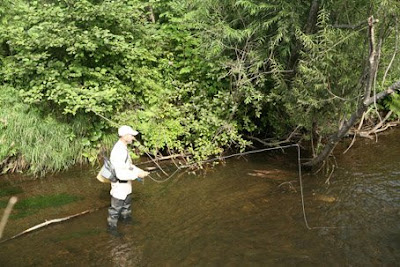The lake is rather shallow and has murky water. Its fish fauna is almost the same as in the Amur River. The most common sportfishes of the lake are Amur pike, skygazer, lake skygazer (gorbushka), Mongolian redfin, and catfish. Non-native species is European walleye (zander) which was stocked by the Russian scientists in nineteen sixtees and seventees.
Khanka Lake looks like a murky freshwater sea. It is imposible to see the opposite bank of the lake - it is too far.
The lake hosts mighty hatches of mayflies, dragonflies.. It is a pity, that at the time of my trip the fish did not come close to the shores, and nothing was feeding of these hatches..

The lake was stormy, and I have decided to fish one its tributaries near the Astrakhanka village
The creek was deep and slow; its current was moving downstream, to the lake

Lake skygazer (gorbushka) was biting imitations of clear freshwater shrimp. These shrimps are numerous in the lake.
 I was lucky to find a school of Mongolian redfin
I was lucky to find a school of Mongolian redfin
 I went further downstream, to the lake. Big waves were moving through the reeds at the creek outlet.
I went further downstream, to the lake. Big waves were moving through the reeds at the creek outlet.
 I was lucky to find a school of Mongolian redfin
I was lucky to find a school of Mongolian redfin
 I went further downstream, to the lake. Big waves were moving through the reeds at the creek outlet.
I went further downstream, to the lake. Big waves were moving through the reeds at the creek outlet. In half of an hour I went back to the lucky place, but everything has changed. The fish was not biting, and even the creek current was moving in the opposite direction - upstream, from the lake. This was caused by the lake "tide" (wind-induced surge). Next time I will try to visit the Khanka Lake in more appropriate time, and in better weather.









 Passing another log jam
Passing another log jam


 On the gravel bars of Poronai there are lots of pieces of coal; we were using it for cooking
On the gravel bars of Poronai there are lots of pieces of coal; we were using it for cooking






 Fish on!
Fish on!












